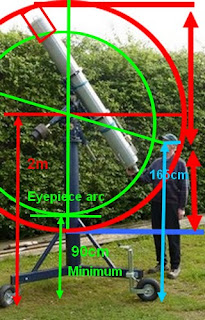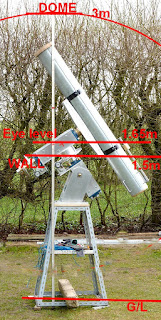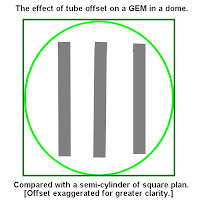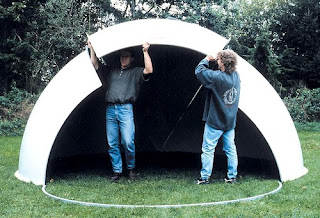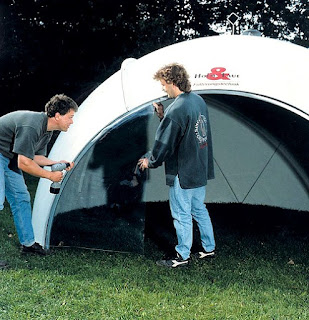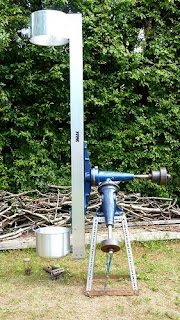*
The lens looked so filthy with collected dust and dried dew that I decided to give it a clean in its cell. I used a rubber bulb, lens, dust blower first. Followed by a gentle brushing with a large, natural bristle make-up brush bought for this precise purpose and no other. The brush is kept in a tube to avoid contamination between uses. More blowing followed, then further brushing with lens cleaning solution added this time. Once I could see no visible residue of dust a wipe with a moist lens tissue followed. A final gentle drying with a well washed microfiber lens cloth completed the task. The bulb lens blower was used repeatedly to help lift any loose particles of dust.
The cleaning was repeated for each side, at each step, to avoid contaminating the second surface with dirty materials or tools. The lens looked fine after another blowing with the lens bulb to evaporate the last remaining film of lens cleaning solution. Though camera flash still revealed an invisible streaking in places. The cleaning materials and tools are then carefully washed and rinsed, dried and then stored in sealed containers until the next [rare] use. No telescope optics should be cleaned any more than absolutely necessary. Even when very dusty they won't show any clearly visible degradation of the image.
-------------------------------------------------------
Thanks to the second balance weight the C of G is now within a centimeter of the center of the huge, main tube. I checked the balance by rolling the OTA [see-saw style] back and forth on a thin steel rod to act as a fulcrum on the workbench. I discovered, years ago, that a larger diameter rod would tip the OTA far too much each way making balancing far too clumsy and slow. Twirling the 1/8" rod slowly with the fingers ensures the telescope tube isn't joggled. A larger wheel would help provide slow motion but I haven't gone that far yet. As the big tube gently finds its own balance point it became more ponderous in its up and down movements. I then marked the tube with adhesive electrical tape for easy registration with the tube rings and Dec axis when it is re-mounted.
Guessing the balance point is very amateurish. A large, long and heavy OTA can easily damage itself badly. Particularly if it is very nose heavy and swings wildly on the mounting! Be warned: Many refractors are very nose heavy!
I always wear industrial rubber gloves for a really safe grip when handling my telescopes. The gloves provide a hugely increased degree of safety and extra insurance against dropping anything. Where bare hands could easily lose the plot for want of a secure hold. I came close to disaster a couple of times before learning this valuable lesson. I now keep gloves just inside the door to give me no excuse for not wearing them. The savings in energy from not having to grip so hard makes them valuable on repetitive tasks. Or where something heavy, or awkward, must be carried a long way.
In the past rubber gloves were of one type. Thick, stiff and heavy canvas with a rather slippery, but initially waterproof PVC[?] surface form dipping. Nowadays a modern, matt glove has an almost sponge-like coating for really extraordinary grip. You can never have enough pairs of gloves "handy" for different jobs. The thinner ones are used by mechanics for handling fine jobs like bicycle repair. The hours saved, in not having to scrub one's hands clean after every job, is well worth the cost. Not to mention the damage to one's skin from endlessly using harsh hand cleaning materials. Prices vary enormously for very similar looking gloves so look around and get something you like and which fit you perfectly. There is no excuse these days for ill-fitting gloves. Loose gloves are worse than those which are too tight. Snugly fitting, without wrinkles or noticeable compression, are best. Try them all on before purchase and look for different weights of glove for different tasks. I even have a box of 100 disposable, surgical gloves which are absolutely superb for cycle repair. Though not long last enough for professional use.
For balancing I use a folding B&D workbench with four widely spaced, large, plastic press-in blocks to ensure the telescope tube cannot possibly roll off. If an OTA did roll off it would be an absolute disaster! With the delicate glass objective very likely to be cracked by the sudden impact with the floor or ground. Never lay any OTA, of any size, on a flat surface and expect it to stay there! Not even for the briefest moment! I saw an antique refractor roll off a sideboard in my youth and crack the irreplaceable lens. I never want to see that ever happen again!
I stand the huge OTA on its nose. [i.e. On its stumpy, 8" permanent dewshield.] With a thick disk of 1.5" plywood made to fit its 10" diameter perfectly with a lip to allow easy removal. The disk is its secure footwear and it must never fall out during lifting. So the big instrument can always be placed safely on the ground or floor for storage or even just for a rest during handling. It then stands 215cm high [7'] between the rafters with the focuser wound right in. The focal length is 216cm. I have a 16" [40cm] long, full dewshield which simply slips snugly over the first to slow up any dewing. The sheer scale of this classical refractor OTA really has to be seen [and felt] to be believed!
Click on any image for an enlargement.
*
